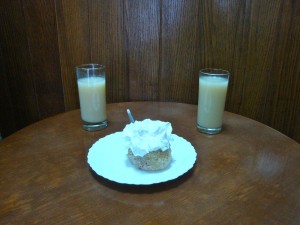Something sweet? Belgrade’s baklava
Americans, picture yourself in a Serbian restaurant. Two hours have passed since you were seated.The Serbians around you are still ordering piles of food, but at this point you are utterly, completely full. The plates of pork prosciutto and mladi cheese are reduced to unidentifiable crumbles. The remaining ajvar has settled into an oily, shallow pool at the bottom of the bowl. The main course-you didn’t think that was the main course, did you?-has been dutifully picked over: roasted meat and vegetables massacred by several forks, and only two scoops of prebanac (baked beans) remain. The waiters clear rakija glasses and offer you another flask of wine. You think you may never eat again.
But it’s not over. The waiter asks, “Something sweet?” Such small, innocent words. Words fit for a tiny petit four or a spoonful of local honey. But you’re in Serbia, and there’s no such thing as a small dish here. You start to protest as your Serbian friends nod vigorously. They discuss options. You think, all the food in my stomach has dislodged a rib. There is no way I am eating dessert. And then…it arrives. And it’s gone before you know it.
There are many great desserts in Belgrade, but one you should try is baklava. Though many think of baklava as a Greek or Turkish dessert, it’s widely available, and delicious, throughout the Balkans. If you’d rather skip the meal and go straight to dessert, I heartily recommend the Baklavdžinica Dukat on Topličin Venac, 3.
They offer a variety of flavors and sizes, from chocolate to pistachio and so on. I prefer pistachio, muz liked chocolate. Either way, you’re not going to be disappointed. If you’d like to know more about the place, check out this great blog post about it.
Balkan Boza: the Malt of Mesopotamia
I’ve written extensively about drinking in the Balkans, prompting concerns that I was becoming a lush. (To which I responded, what do you mean, becoming? Kidding, folks! Mostly). Anyway, when I read Balkan Insight’s article about boza, the non-alcoholic malted drink popular with children, I knew I had to try it–and share it with you, dear readers.
Boza originated in Mesopotamia eight or nine thousand years ago and was popularized in the Ottoman Empire during the 10th century. In the 17th century the Sultan categorized boza as alcoholic, effectively banning the drink. But banning things doesn’t make them less popular; the boza bonanza spread through the Balkans during Ottoman occupation. Every region has a different recipe, but Serbian boza is made with water, fermented corn grain, yeast and sugar. (Or something like that. Every recipe I read was a little different.)
Though bottled boza exists, we were after the real thing: boza freshly made in a poslasticarnica/sweet shop. We hit paydirt with the poslasticarnica Belgrade Insight recommended on Makedonska, just south of Republic Trg. This place is the real deal. The floor was linoleum, the walls were wood-paneled, and the dessert case was full of fresh goodies: Turkish delight, krem pita, cookies, baklava, and everything else designed to knock a girl off her diet. Solely in the name of research, I ordered tufahije, a walnut-stuffed apple stewed in water with sugar, to go with our boza.
The boza was tangy and super sweet. It reminded me of a mix of coconut milk and pineapple juice, with the slightest bit of grit from the corn grain. It was distinctive, and I can understand why people (especially kids) would have fond memories of it. I was glad I tried it, since it’s probably one of the oldest man-made beverages after beer, but I won’t be having a glass of boza after a hard day of housewifery.
Though I’m not bananas for boza, I considered the outing a great success. The poslasticarnica was delicious, and a great find. Great for muz, that is. Bad for my skinny jeans…









